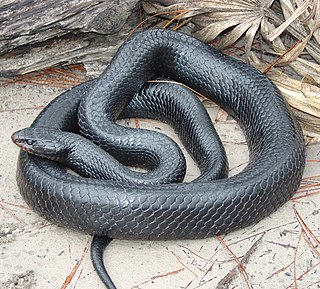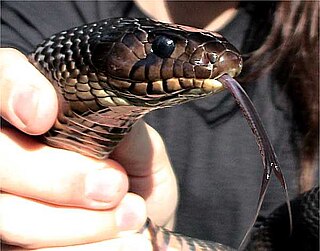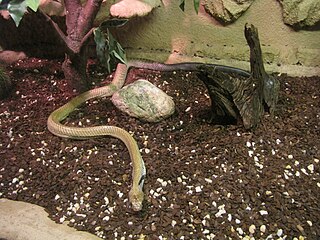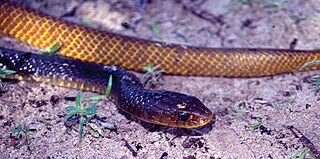
Pantherophis obsoletus, also known commonly as the western rat snake, black rat snake, pilot black snake, or simply black snake, is a nonvenomous species of snake in the family Colubridae. The species is native to central North America. There are no subspecies that are recognized as being valid. Its color variations include the Texas rat snake. Along with other snakes of the eastern United States, like the eastern indigo snake and the eastern racer, it is called “black snake”.

Garter snake is the common name for small to medium-sized snakes belonging to the genus Thamnophis in the family Colubridae. They are native to North and Central America, ranging from central Canada in the north to Costa Rica in the south.

Leiopython is a genus of snakes in the family Pythonidae.

The Acrochordidae, commonly known as wart snakes, Java wart snakes, file snakes, elephant trunk snakes, or dogface snakes are a monogeneric family created for the genus Acrochordus. This is a group of basal aquatic snakes found in Australia and tropical Asia. Currently, three species are recognized.

The eastern indigo snake is a species of large, non-venomous snake in the family Colubridae. Native to the southeastern United States, it is the longest native snake species in the country.

Clelia is a genus of snakes, one of three genera with species with the common name mussurana or musurana. Clelia is a genus of large snakes in the family Colubridae. The genus is native to Central America and South America, and species of Clelia are found from southern Mexico to Brazil. They specialize in ophiophagy, i.e., they attack and eat other snakes. Currently seven species are recognized as being valid. They have other popular names in various countries, such as zopilota in Central America and cribo on some Caribbean islands.

Drymarchon is a genus of large nonvenomous colubrid snakes, commonly known as indigo snakes or cribos, found in the Southeastern United States, Mexico, Central America, and South America.

Drymarchon melanurus erebennus, commonly known as the Texas indigo snake, is a subspecies of large, nonvenomous snake in the family Colubridae. The subspecies is native to Texas in the United States and adjacent Mexico.
Wolfgang Wüster is a herpetologist and Professor in Zoology at Bangor University, UK.

The Colubrinae are a subfamily of snakes within the family Colubridae. It includes numerous genera, and although taxonomic sources often disagree on the exact number, the Reptile Database lists 717 species in 92 genera as of September 2019. It is the second largest subfamily of colubrids, after Dipsadinae. Many of the most commonly known snakes are members of this subfamily, including rat snakes, king snakes, milk snakes, vine snakes, and indigo snakes.

Hydrophis is a genus of sea snakes, venomous snakes in the subfamily Hydrophiinae of the family Elapidae. Species in the genus Hydrophis are typically found in Indo-Australian and Southeast Asian waters. Currently, around 36 species are recognized as being valid.
The unicolor cribo is a Central American subspecies of the cribo snakes. The eastern indigo snake, Drymarchon corais couperi is another species of this genus. Until recently the unicolor cribo was considered a subspecies of the same species as the indigo snake Drymarchon corais unicolor.
Pritchard's snake-necked turtle is a species of turtles in the family Chelidae. The species is endemic to a restricted area of Central Province, Papua New Guinea.

Crotalus stejnegeri, commonly known as the Sinaloan long-tailed rattlesnake or just long-tailed rattlesnake, is a venomous pit viper species in the family Viperidae. The species is native to western Mexico. There are no recognized subspecies.
The narrow-headed garter snake, Thamnophis rufipunctatus, is a species of garter snake, endemic to the southwestern United States and adjacent northwestern Mexico. Its common names also include narrowhead garter snake and narrowhead watersnake.

The Middle American indigo snake, also known commonly as the blacktail cribo, is a species of large, nonvenomous, snake in the family Colubridae. The species is native to the southwestern United States, Mexico, Central America, and northern South America. In addition to the nominate subspecies, it has four other recognized subspecies, including D. m. erebennus, commonly known as the Texas indigo snake.

The indigo snake, also known as the yellow-tail cribo, is a species of snake in the family Colubridae. This large colubrid snake is nonvenomous.
The Margarita indigo snake is a species of non-venomous snake in the family Colubridae. The species is endemic to the island of Margarita, Nueva Esparta in Venezuela.














